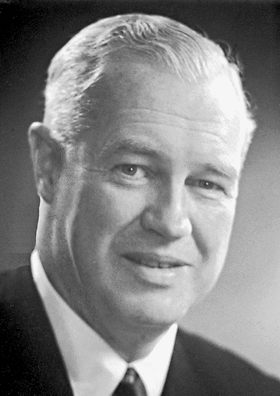Alexander R. Todd facts for kids
Quick facts for kids
The Lord Todd
|
|
|---|---|

Todd in 1957
|
|
| Born |
Alexander Robertus Todd
2 October 1907 Cathcart, Scotland
|
| Died | 10 January 1997 (aged 89) Oakington, England
|
| Alma mater | University of Glasgow University of Frankfurt am Main University of Oxford |
| Awards | Davy Medal (1949) Royal Medal (1955) Nobel Prize for Chemistry (1957) Paul Karrer Gold Medal (1963) Copley Medal (1970) Lomonosov Gold Medal (1978) |
| Scientific career | |
| Fields | Chemistry, Biochemistry |
| Institutions | Lister Institute University of Edinburgh University of London University of Manchester University of Cambridge Christ's College, Cambridge University of Strathclyde Hatfield Polytechnic |
| Doctoral advisor | Walter Borsche, Sir Robert Robinson |
| Doctoral students | J. Rodney Quayle |
Alexander Robertus Todd, Baron Todd was a brilliant British scientist. He was born on October 2, 1907, and passed away on January 10, 1997. He was a biochemist, which means he studied the chemistry of living things. His amazing work on tiny building blocks of life, like nucleotides, helped him win the Nobel Prize for Chemistry in 1957. These discoveries were super important for understanding DNA and RNA.
Contents
Early Life and Learning
Alexander Todd was born in Cathcart, a town near Glasgow, Scotland. His father, also named Alexander, worked for the Glasgow Subway. His mother was Jane Lowry.
He went to Allan Glen's School. Later, he earned his first degree from the University of Glasgow in 1928. He then traveled to Germany and received another doctorate degree in 1931. This degree was from the Johann Wolfgang Goethe University of Frankfurt am Main. His research there was about the chemistry of bile acids.
Todd continued his studies at Oriel College, Oxford, in England. He received a special scholarship called the 1851 Research Fellowship. He earned his second doctorate in 1933.
Amazing Discoveries and Career
Alexander Todd held many important jobs during his career. He worked at the Lister Institute and the University of Edinburgh. He also taught at the University of London as a Reader in biochemistry.
Working on Life's Building Blocks
In 1938, Todd visited the California Institute of Technology in the United States. He then became a professor at the University of Manchester in England. This is where he started his groundbreaking work on nucleosides. These are the basic units that make up nucleic acids, which include DNA and RNA. DNA and RNA are like the instruction manuals for all living things.
In 1944, he moved to the University of Cambridge. He became a professor there and stayed until he retired in 1971.
Synthesizing Important Molecules
Todd made some very important molecules in his lab. In 1949, he created adenosine triphosphate (ATP) and flavin adenine dinucleotide (FAD).
- ATP is like the energy currency of cells. It powers almost everything living cells do.
- FAD helps cells create energy from food.
He also helped figure out the structure of vitamin B12 in 1955. Another scientist, Dorothy Hodgkin, and her team later confirmed the final structure. Todd also worked on other vitamins, like vitamin B1 and vitamin E. He studied anthocyanins, which are the colorful pigments found in flowers and fruits.
Leading Science Policy
From 1952 to 1964, Alexander Todd was the chairman of the British government's committee on scientific policy. This meant he advised the government on important science decisions.
Academic Leadership
Todd was elected a Fellow of Christ's College, Cambridge in 1944. He later became the Master of the college from 1963 to 1978. He also became the Chancellor of the University of Strathclyde in 1975.
He received many awards and honors throughout his life. He was elected a Fellow of the Royal Society in 1942. This is a very prestigious group of scientists. He also became a member of the United States National Academy of Sciences in 1955. From 1975 to 1980, he was the President of the Royal Society. In 1977, he was made a member of the Order of Merit, a special honor given by the British monarch.
In 1981, Todd helped start the World Cultural Council, an organization that promotes culture and education.
Personal Life and Passing
In 1937, Alexander Todd married Alison Sarah Dale. Her father, Sir Henry Hallett Dale, was also a Nobel Prize winner and a president of the Royal Society. Alexander and Alison had three children: a son named Alexander Henry, and two daughters, Helen Jean and Hilary Alison.
Alexander Todd passed away in Cambridge on January 10, 1997, at the age of 89. He died after having a heart attack.
Honors and Recognition
Todd received many special invitations to lecture at universities around the world. He was a Nieuwland Lecturer at the University of Notre Dame in 1948. He was also an Arthur D. Little Visiting Professor at Massachusetts Institute of Technology in 1954. In 1957, he was a Hitchcock Lecturer at the University of California, Berkeley.
He was knighted as Sir Alexander Todd in 1954. This means he received the title "Sir." In 1962, he was made a Baron Todd, which gave him a seat in the House of Lords.
A special blue plaque was put up by the Royal Society of Chemistry at the Department of Chemistry in the University of Cambridge to remember his work.
|
See also
 In Spanish: Alexander Robert Todd para niños
In Spanish: Alexander Robert Todd para niños
- Atherton–Todd reaction
- History of RNA biology
- List of RNA biologists
- List of presidents of the Royal Society

